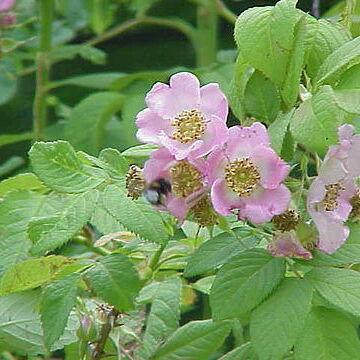Shrubs 1.5–3 m tall. Branchlets purple-brown, robust; prickles absent or if present, in pairs below leaves, straight. Leaves including petiole 7–15 cm; stipules broad, mostly adnate to petiole, free parts ovate, usually glabrous, margin glandular serrate, apex shortly acuminate; rachis and petiole villous, sparsely glandular-pubescent, sometimes shortly prickly; leaflets (7 or)9–11(–13), oblong or elliptic-ovate, 2.5–6 cm, abaxially villous, glandular or not, with prominent veins, adaxially glabrous, with concave midvein, base rounded, rarely broadly cuneate, margin simple or doubly serrate, apex acute, rarely rounded-obtuse. Flowers solitary, or 2 or 3 and fasciculate, 3.5–5 cm in diam.; pedicel 1.5–2.5 cm, densely stipitate glandular or not; bracts 1 or 2, long ovate, 1.5–2.5 cm, abaxially puberulous along midvein or glabrous, with prominent midvein and lateral veins, margin glandular-pubescent, apex acuminate. Hypanthium ovoid or long obovoid, densely stipitate glandular. Sepals 5, ovate-lanceolate, 2–3.5(–5) cm, abaxially stipitate glandular, sparsely pubescent or not, adaxially densely pubescent, margin entire, apex long caudate. Petals 5, deep red, obtriangular-obovate, base broadly cuneate, apex emarginate. Styles free, much shorter than stamens, pubescent. Hip purple-red, oblong-ovoid or long obovoid, 1.5–3 × ca. 1.5 cm, stipitate glandular or not, shiny, with a short neck at apex, with persistent, erect sepals. Fl. Jun–Jul, fr. Aug–Nov. 2n = 14.
More
A shrub. It grows 2 m high. It has few prickles. The prickles are straight with a broad, expanded base. The leaves have stalks. The leaves are divided into 5-9 leaflets with an odd number. These are divided along the stalk without leaflet stalks. They have fine teeth and are hairy underneath. The flowers are large and occur singly. They are pinkish red and at the ends of branches. The fruit are very large. They can be 5 cm long. They are red, bristly and flask shaped. They are edible.

